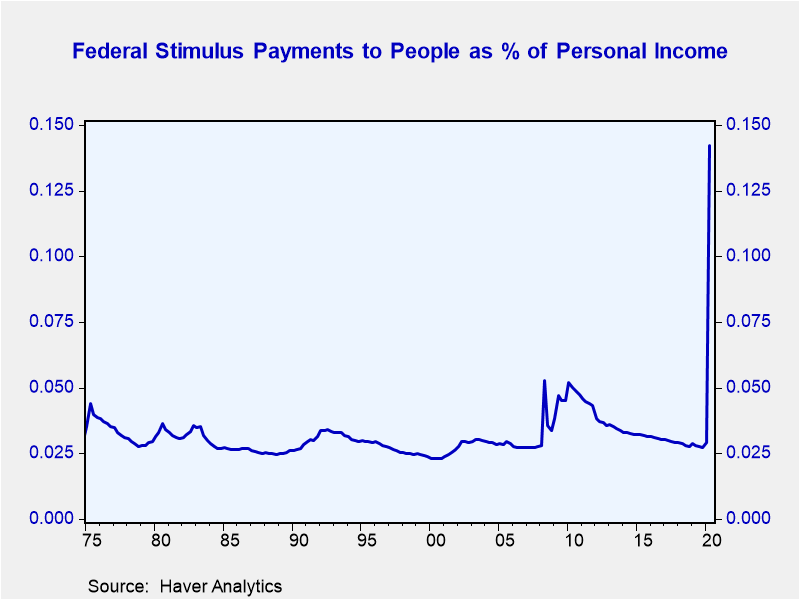 Global| Aug 20 2020
Global| Aug 20 2020Taking Away the "Punch Bowl": Risk of Hard Landing in Consumer Spending
|in:Viewpoints
Summary
With each passing day, the failure of Congress and the Administration to reach a deal on extending fiscal stimulus creates a bigger and bigger hole in consumer cash flow. So far investors have brushed off the stalemate. But that’s a [...]
With each passing day, the failure of Congress and the Administration to reach a deal on extending fiscal stimulus creates a bigger and bigger hole in consumer cash flow. So far investors have brushed off the stalemate. But that’s a mistake.
That's because the federal stimulus payments that flowed to people in Q2 was the largest on record. Removing the "punch bowl" of stimulus entirely or even in half raises the risk of a hard landing in consumer spending.
According to the Bureau of Economic Analysis (BEA), special federal payments to individuals and small businesses (proprietors) in Q2 boosted personal income by $ 3.2 trillion annualized. That figure includes direct stimulus payments, an increase in unemployment compensation to a broader group of workers, and forgivable loans to small businesses (proprietors) that are included in the personal income data.
The actual boost to consumer cash flow was even larger because millions on renters and homeowners were allowed to forgo monthly rent and mortgage payments.
So how big is $3 trillion in federal payments to people? It’s humongous.
Here are two examples.
First, the federal payments of $3.2 trillion to people and small businesses equaled nearly 15% of personal income. To put that in perspective, personal tax payments in 2019 totaled $2.2 trillion, or 12% of personal income.
So the scale of stimulus payments Congress sent to people in Q2 was $1 trillion more than what people pay in taxes for an entire year. Never before has any federal tax cut or special payment to people has ever come close to something of that scale.
Second, Q2 wage and salary income totaled $8.85 trillion, off $680 billion from Q1 level. That means the infusion of $3.2 trillion in payments to people was nearly 5X times the amount of lost income due to job loss, fewer hours worked, and wage cuts.
In other words, Congress appropriated more spendable income to people than what was lost from the record 20 million-plus employment losses emanating from the closure of the economy.
The punch bowl reference is often related to monetary policy. Fed chairman William McChesney Martin once argued that the central bank's role is to take away the punch bowl just when the party's going well. What Mr. Martin meant was that if policymakers applied the monetary brakes sufficiently in scale and in time policymakers would have avoided excesses and imbalances from developing and therefore reduce the need for more forceful action that could send the economy off the cliff.
The punch bowl nowadays is centered on fiscal policy. Congress provided record payments to people in Q2 and cutting that off completely before labor markets are fully healed runs the risks of pushing the consumer and the economy off the cliff.
Just do the math. In Q2, fiscal payments to people equaled nearly $35 billion a day, or roughly $250 billion a week. With jobless claims at 1.1 million for the week ending August 15, it will not take long before the lack of federal support shows up in all areas of consumer spending.
Viewpoint commentaries are the opinions of the author and do not reflect the views of Haver Analytics.Joseph G. Carson
AuthorMore in Author Profile »Joseph G. Carson, Former Director of Global Economic Research, Alliance Bernstein. Joseph G. Carson joined Alliance Bernstein in 2001. He oversaw the Economic Analysis team for Alliance Bernstein Fixed Income and has primary responsibility for the economic and interest-rate analysis of the US. Previously, Carson was chief economist of the Americas for UBS Warburg, where he was primarily responsible for forecasting the US economy and interest rates. From 1996 to 1999, he was chief US economist at Deutsche Bank. While there, Carson was named to the Institutional Investor All-Star Team for Fixed Income and ranked as one of Best Analysts and Economists by The Global Investor Fixed Income Survey. He began his professional career in 1977 as a staff economist for the chief economist’s office in the US Department of Commerce, where he was designated the department’s representative at the Council on Wage and Price Stability during President Carter’s voluntary wage and price guidelines program. In 1979, Carson joined General Motors as an analyst. He held a variety of roles at GM, including chief forecaster for North America and chief analyst in charge of production recommendations for the Truck Group. From 1981 to 1986, Carson served as vice president and senior economist for the Capital Markets Economics Group at Merrill Lynch. In 1986, he joined Chemical Bank; he later became its chief economist. From 1992 to 1996, Carson served as chief economist at Dean Witter, where he sat on the investment-policy and stock-selection committees. He received his BA and MA from Youngstown State University and did his PhD coursework at George Washington University. Honorary Doctorate Degree, Business Administration Youngstown State University 2016. Location: New York.



